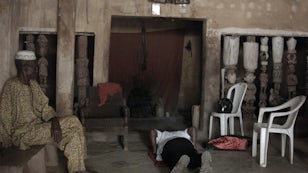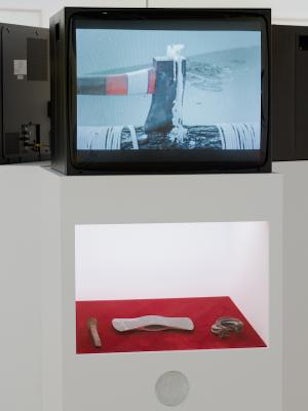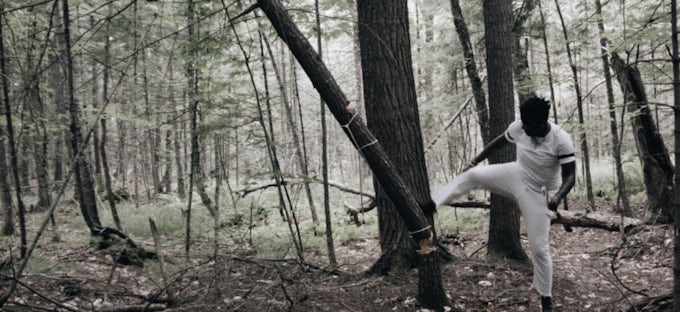
Tiona Nekkia McClodden’s work explores gender, sexuality, spiritual practice, knowledge reclamation, re-memory and conceptualisations of time across the African Diaspora and in relation to Black life. Alongside her artistic practice, Tiona is also a curator. In 2017–2018 she co-curated an exhibition on the life, work, and resurgent influence of Julius Eastman 01 and in 2019 an exhibition and symposium taking a deep dive into the peripheries of Robert Mapplethorpe’s practice at a particular historical moment. For I prayed to the wrong god for you, a work presented in the Whitney Biennial 2019 focused on her relationship with her spiritual practice, she was awarded the Bucksbaum Award. In the work, she displays a set of wooden tools, documenting their production under directive of the Yorùbá deity Shango. Initiated as a priestess of Ogun in Santería, the ritual imperatives and duties of this Afro-Cuban religious tradition are now an integral part of her practice. This interview foregrounds her responsibilities as a priestess and the tools her initiation affords her, considering how they inform her artistic output.
Adjoa Armah: I’m interested in understanding how you situate the art world in your spiritual duties, which you explore in I prayed to the wrong god for you (2019). Could you talk me through your relationship with Santería and how you got to your position within this tradition?
Tiona Nekkia McClodden: I initiated in 2012. At that time, people were thinking 2012 was gonna be the end of the world, but this was when this parallel new tract of my life opened – my ‘threshold life’, as I call it. My origin story in being interested in these practices started when I was a kid. My way in was through a book on West African art which allowed me to read spiritual texts next to images of sculpture, in contrast to the bible texts I grew up with. I felt the foundational elements of Christianity were not working for us as a community. It was easy to traverse as a kid, because of my family’s struggles being poor, being homeless, from the South; through this book I was able to traverse that thing between colonialism and Christianity that keeps you very bound to the idea of blasphemy. It helped me get around my feelings surrounding blasphemy; I was able to read about these religions and come to something that feels like a birth-right. Actually, something that is a return, something that is in me that I just needed to return to.

AA: Increasing numbers of the Diaspora appear to be interested in reconnecting with older traditions, older forms of thought and practice. This impulse to reconnect to precolonial spiritual life sometimes necessitates alienating oneself from parts of one’s community or support network. How has that been for you?
TNM: There are two things I want to talk about. First, this general idea and then my specific experience. The larger case is what it means to look at certain systems, and I’m speaking from my positionality as a Black American sitting in 2019 vs 1619, which is 400 years since the first slave ship came to this country. We are in this 400–year moment, so what does it mean for me right now to be this practitioner who is finding more people interested in being what we call above ground New World practitioners, because there have been a lot underground. People are now saying we want to bring this into our work, or we want to bring this into public spaces, or we want to present certain signifiers that are very visible for each other.
Before initiating, for seven years, I was having fractious conversations with Santería Padrinosand Madrinas – godfathers and godmothers – in the US. With a lot of these American extensions of practice, you end up having to engage with people that are still influenced by Christianity. Some of the things I came up against, particularly within the American South, had a lot to do with my sexual orientation and my queerness, my visible queerness. I knew that when I found a place, those things would not matter, so I just took my time. I didn’t want to enter a practice that would diminish any of my identities.
AA: Certain knowledge in this tradition can’t or shouldn’t be accessible to everyone. I’m interested in how you navigate that, and the parts of this journey that you feel should not be of the art world.
TNM: That’s why I look at syncretism as a reference, particularly how syncretism manifests in material culture for cues around form, iconography, etc, that I bring into my work. These cues from material culture created a great space for me to be so interior, so autobiographical, because I knew that what I’d show would still be reduced to a very basic idea of form in the American context. That it would become about colour, shape, etc. As someone who is initiated as a priestess, this art production is in very odd ways just as important as the prayers for the gods.

The beauty of being able to present this as work is knowing that I have something which defies the way people are attuned to see. I prayed to the wrong god for you is a six-channel work. You have to be a six-headed monster to see it – even then, you will not see everything. There is a denial about the running time. I have an infinite duration. I am interested in frustrating people who feel like they should have access to this information. At the same time I am interested in being very clear that I am of this. When you see the work, you are seeing the work. Hence the gesture I made in I pray to the wrong god for you, where I have the tools consecrated. I don’t want people to get it twisted and think that the work being done stops at art.
AA: I really want to discuss what is supposed to happen within that exhibition space. How do you bring ritual to an audience?
TNM: This is my work. It’s also my life. I’m cagey – I’m notoriously like this with most curators – I’ll just show up with the idea. They don’t know and maybe I don’t know what this thing is supposed to do until I step into this room. I’m not gonna be bound by a script. I’ve got a shrine in the Whitney right now: the goal was to create a simulacrum of sorts of the shrine that I go and visit.
In American art, the Whitney Biennial is the one show in which you can’t hide behind abstraction. No matter what you do, the work will be tied to you. Your personhood, your body, etc. I knew it would be that way. So this work is very much about my body. It is figurative. It is also situated with the body in certain kinds of cues which are tied to different religious ideas of prayer and possession. Coming from a filmmaking background, my core investment in filmmaking is the suspension of belief. The thing that gets into your head that allows you to believe what you are watching. That takes you out of this world.

I’m really trying to cross a threshold and deal, in a way with a pleasant violence of the haptics that come with putting a film installation with sound in a physical space. The thing that I am interested in with my sound is that it spills over. It is not consensual. It crosses the boundaries – you’re going to have to leave that room to get away from me. To go into what it means, this was something that was meant to be a ritual. Part of the things that people know that one must do for Shango, or know about Shango, the things that he needs to be signalled.
I’m doing that as a gesture, so that this loud energy, I knew that was gonna come through the show would come from my life as well in relation to my practice. With Shango, especially with me being a child of Ogun, it’s like ‘please let me work, there are things that I need to learn from you.’ But these things also need to be tempered. I am very much a child of Ogun in the sense that I’m cool with laying back and them just leading the work. There is something about this art world and the way I am being moved in it especially in the last few years when I am realising there is so much invested in who you are as a person and maybe I wasn’t prepared for what was happening to me last year. What came up is that I need to learn how to be in the world. I need to learn how to be with this kind of energy. I need to be brave, I need to get used to not so much limelight but I need to get used to what that feels like, even if I don’t indulge in those things. This work is a representation of that. It’s the energy of this bravado. It’s very very very chest out. It made me more confident than I would ever be in my body. So it’s very pronounced and that energy is imminent within that space, imminent in that building.
One of the things that I look to challenge with the work is that it’s tied to a certain religiosity. What it means to deal with cosmology or the fact that I don’t want to call it religion – it is a system. I was thinking about how that system works within a space. The kind of work that is demanded from the Whitney to present it; it’s almost as though I wanted that work too. I wanted labour, you know, I wanted labour from the audience. I want labour from the institution.
AA: Following on from your desire for labour, could you talk about tooling and the different ways you relate to the tools you have to hand?

TNM: As you progress as a filmmaker there becomes this ‘handlessness’ – there are 50 people who have their hands on your stuff, and you just sit and direct, so you are able to produce something that is beyond your hands. It’s very in your head. To me that’s what film is. The thing that I am chasing is what it means to make things at the limitations of my own hand. What does it mean to say that everything that I make, will I shoot myself?; I will edit myself; Will I do the sound myself? I put myself back into this space because it focuses on my body and what is able to be created from it. I am interested the conceptual practice also being outside of your head. Make it with your hands. So you can know what it takes, but you can also know when to stop. Know when it hurts. Then look at what you have done. Assign value, whether that value is my own measuring system or whether it is attached to financial capital in the art world.
AA: In filmmaking there’s an assumption that the potential for scale, for bigness, increases when you have the involvement of many pairs of hands. But I’m interested in this sense that the process is not bound by the limits of what your hand can or can’t do – that the body enables that largeness, that scaling up.
TNM: I am interested in Black density. I want things to be extraordinarily dense and not easily flattened or silhouetted out. To concentrate on the relationship I have with the various intersections of all the identities that I have – Black woman, Queer woman, BDSM practitioner, priestess… The fight to stay big is to demand the respect of all the communities that you are a part of. That is my interest in bigness. Fullness. To say you can’t deny me any of these things even though I know all these things make you feel uncomfortable or defy what you think can be in a single figure.

AA: I am really interested in your relationships with elders and community, whether this is other Black or Queer artists, ancestors, spiritual practitioners, Orisha. How do you think of yourself amidst these relations?
TNM: I am an artist that likes to disclose their references. I want you to know where I got my shit from. I am bound by people, I am interested in how people trouble the distinction between truth and fact. Truth being people and facts being materials that are left over – facts are material culture. I like the derailing aspect of what it means to be bound by people. They can come in with a certain kind of passion and truth which sits outside of your knowledge. I like the seduction, the finesse of the convincing that people do to make you believe and I like to look at that as source material. Community, for this work or any other work, the part of being bound to them is to open yourself up for critique, which means that you must disclose that you are part of them. With the work at the Whitney I knew that I couldn’t go and follow someone on their spiritual journey, I had to out myself to the majority of people who don’t know that I am a priestess.
Footnotes
-
Recollection . + Predicated., was part of Julius Eastman: That Which is Fundamental by Bowerbird, a Philadelphia based non-profit arts organisation (5–26 May 2017) and at the Kitchen, New York (19 January – 10 February 2018).
-
There Are No Shadows Here: The ‘Perfect Moment’ at 30 at Washington Project for the Arts (18 July – 19 August 2019). (missing references)
